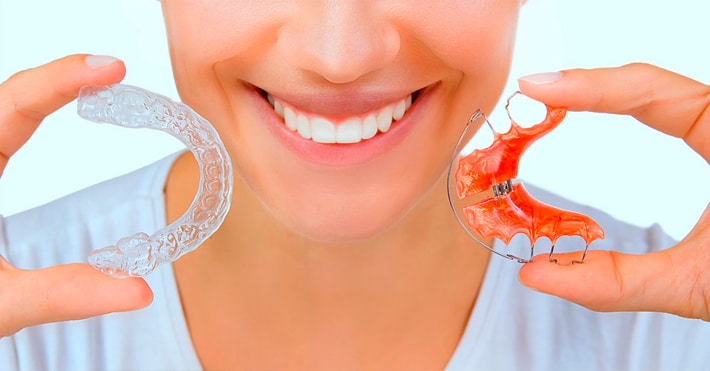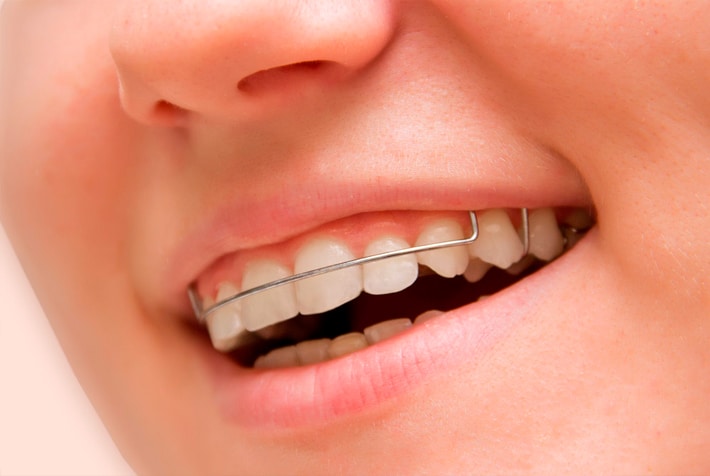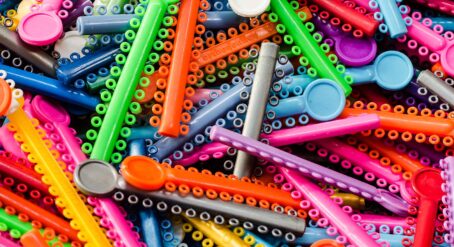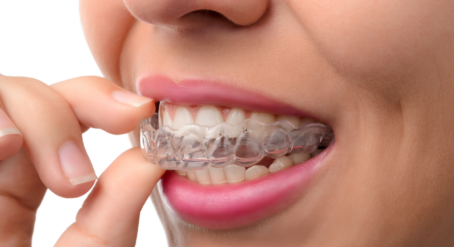Orthodontic treatment with braces or clear aligners will create a beautiful smile, but wearing retainers afterwards is what maintains and protects the smile into the future. Retainers are key to maintaining the success of orthodontic treatment over the long term. In fact, wearing retainers is equally as important as the orthodontic treatment itself!
What is an orthodontic retainer?
A retainer is an orthodontic device that is designed to help teeth «retain» their new position. Teeth move throughout our life and without a retainer, the teeth will shift again.
A retainer is designed to keep the teeth where the previous braces/aligner treatment moved them. To properly maintain the results your investment deserves, retainers must be worn according to the guidelines set by your orthodontist.
But let’s face it – getting into the habit of wearing a retainer correctly and keeping it safe can be a challenge! Here’s all you need to know about the importance of retainers, alongside some tips for use and safekeeping.
The importance of a retainer
In a nutshell, they are custom-made orthodontic appliances that are designed to hold the teeth in their new positions after orthodontic treatment. If they are not worn as instructed by your orthodontist, the teeth can definitely go crooked again.
It is vitally important to understand that it takes time for a mouth to ‘learn’ the new positioning of their teeth once braces are removed. While some minor changes to the bite and tooth alignment post-treatment are normal, wearing a retainer for as long as your orthodontist recommends is the best way to ensure their teeth stay healthy and straight for years to come.

Permanent vs removeable retainers
There are two types of retainers that you can have after you finish your braces treatment: permanent or removeable.
Permanent
A permanent or fixed retainer is a wire that is glued to the inside (i.e. tongue side) of the teeth to help prevent the teeth from shifting over time. They are similar to lingual braces in their appearance. When it comes to cost, most orthodontists who use permanent retainers include their placement in your overall treatment fee, however, a relatively small fee for their long-term maintenance and/or replacement may be charged.
There are also some pros and cons of having a permanent retainer that can help you work out if this post-treatment option is right for you and keeping your teeth straight:
- Pro: They’re permanently attached to your teeth, so you don’t have to actively remember to wear them.
- Pro: If they are not damaged, they can predictably hold the front teeth straight.
- Con: It can be harder to keep it clean and floss your teeth, and food can be trapped more easily.
- Con: For some people, it can cause some initial discomfort or a slight lisp whilst their tongue gets used to the wire.
Removeable
Removable retainers come in two main types, traditional plates or clear retainers. These need to be taken out for eating, cleaning, and sport. A traditional plate retainer is also known as a Hawley and/or Begg retainer. It consists of a moulded acrylic base that is custom-fitted to the roof of the mouth. This type of retainer has been around for decades and continues to be a reliable option after braces.
Clear retainers are essentially a very thin clear mouthguard. They are made from a clear plastic that is created from a mould or scan of the teeth once the braces are removed. You shouldn’t feel any discomfort or pressure from the retainer if worn correctly and consistently.
Here is a quick list of the pros and cons that come with wearing a removable retainer:
- Pro: Because you can take out these retainers, they’re much easier to clean.
- Pro: You can take them out to eat food
- Con: You need to wear them consistently for them to hold your teeth straight
- Con: Some people find it a bit difficult to speak when they first wear a removable retainer.
How long do you need to wear your retainer for?
Most patients who have permanent fixed orthodontic retainers (a thin wire placed behind the front upper and/or lower teeth that it is not visible from the front) are encouraged to keep these wires in place for as long as possible and have regular dental check-ups.
Patients with only removable retainers will generally need to wear their retainer every night for as long as possible.
Faces, teeth and jaws will inevitably change as we age, but every person is unique. Therefore, only your orthodontist will be able to advise which type of retainer is right for you and how often and for how long you should be wearing it.
What should you do if your retainer gets bent or moves?
If your clear plastic retainer has been slightly bent out of shape, it may not fit properly. This should be checked by your orthodontist. If your permanent retainer feels different or has dislodged, it’s best to contact your orthodontist and book an appointment straight away. They’re the best person to assess and fix your retainers!

5 tips for living with a removable retainer
1. Keep it safe
When the retainer is not being worn, it should always be kept safe in its container so it won’t be damaged or lost. Wrapping it in a napkin or tissue isn’t a good idea as it’s more likely to get lost or accidentally thrown away.
2. Clean it regularly
Retainers are exposed to the same bacteria and plaque as the rest of your mouth. Like teeth, they need to be cleaned (or at least rinsed) after every meal. Ensure your child cleans their retainer as they would their teeth, with a gentle brush. Retainers can also be soaked with a cleanser tablet or mouthwash to keep them fresh and germ-free – ask your orthodontist for a recommendation as to which brands are best to use.
3. Protect it from damage
Retainers are mostly plastic, and the two most common ways they can be damaged are from heat and from physical distortion. Retainers shouldn’t be placed in hot water, the dishwasher, washing machine, direct sunlight or near a heat source – they’ll easily warp. Caring for a retainer properly will ensure it lasts the distance!
4. Know when to remove it
Retainers should always be removed before eating and toothbrushing as well as when swimming or playing sports.
5. Schedule regular retainer check-ups
And if the retainer starts to lose shape or isn’t fitting correctly, call your orthodontist immediately.
4 tips for living with a fixed retainer
1. Focus on hygiene
A fixed retainer can be a food/plaque trap, therefore it should be brushed twice daily, and flossed at least once daily. Your orthodontist will demonstrate how to do this properly on the day when the fixed retainer is fitted.
2. Protect it from damage
Just like braces, fixed retainers can break if you chew something hard, or if you pick it with your fingernails, toothpicks etc. Therefore, be mindful what you eat, and if possible, avoid foods that could potentially break or distort the retainer wire. Chewing ice and/or pens is definitely not recommended either!
3. Call your orthodontist if something does not feel right
If the fixed retainer feels loose, or if you can feel something sharp, contact your orthodontist immediately.
4. Have it checked regularly
It is important to see your orthodontist for regular retainer checks. If you are no longer under the active care of your orthodontist, then it’s important you see your dentist for your regular six-monthly dental check-ups. Your orthodontist or dentist will be able to tell you if the fixed retainer is still intact, or if it needs to be repair or replacement.
Although it can be tempting to neglect this final step, it’s important to understand the importance of wearing retainers once your braces are removed. Wearing a retainer and caring for it properly will help ensure you keep your beautiful new smile for the rest of your life!










